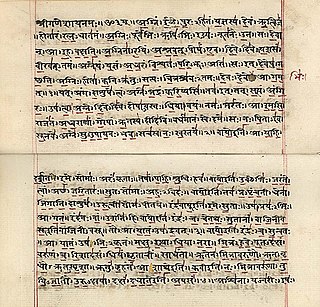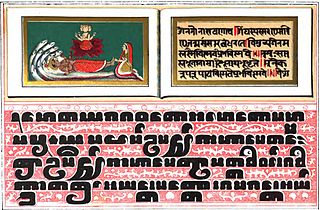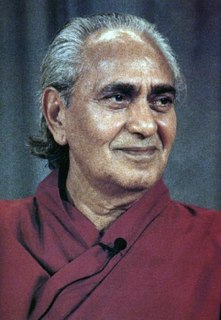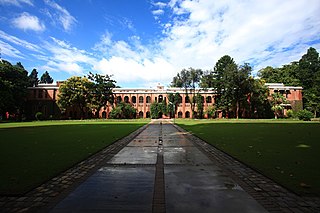Patañjali is the name of a renowned sage in hinduism who is thought to be the author of a number of Sanskrit works. The greatest of these is the Yoga Sutra, which is the source of modern day yoga. There is doubt as to whether the sage Patañjali is the author of all the works attributed to him as there are a number of known historical authors of the same name. A great deal of scholarship has been devoted over the last century to the issue of the historicity or identity of this author or these authors.

Yoga is a group of physical, mental, and spiritual practices or disciplines which originated in ancient India. Yoga is one of the six orthodox schools of Hindu philosophical traditions. There is a broad variety of yoga schools, practices, and goals in Hinduism, Buddhism, and Jainism. The term "yoga" in the Western world often denotes a modern form of Hatha yoga, consisting largely of the postures called asanas.

A yogi is a practitioner of yoga, including a sannyasin or practitioner of meditation in Indian religions. The feminine form, sometimes used in English, is yogini.
Siddhis are spiritual, paranormal, supernatural, or otherwise magical powers, abilities, and attainments that are the products of spiritual advancement through sādhanās such as meditation and yoga. The term ṛddhi is often used interchangeably in Buddhism.

Vyasa is a central and revered figure in most Hindu traditions. He is also sometimes called Veda Vyāsa or Krishna Dvaipāyana. He is generally considered the author of the Mahabharata, as well as a character in it and the scribe of both the Vedas and Puranas, also known as Puranik. Vyasa is also considered to be one of the seven Chiranjivins, who are still in existence according to Hindu tradition.

Brahmacharya is a concept within Indian religions that literally means "conduct consistent with Brahma". In simple terms on the path of Brahma..

Traditionally, an ashram is a spiritual hermitage or a monastery in Indian religions.

The Yoga Sūtras of Patañjali are a collection of 196 Indian sutras (aphorisms) on the theory and practice of yoga. The Yoga Sutras were compiled prior to 400 CE by Patanjali who synthesized and organized knowledge about yoga from older traditions. The Yoga Sūtras of Patañjali was the most translated ancient Indian text in the medieval era, having been translated into about forty Indian languages and two non-Indian languages: Old Javanese and Arabic. The text fell into relative obscurity for nearly 700 years from the 12th to 19th century, and made a comeback in late 19th century due to the efforts of Swami Vivekananda, the Theosophical Society and others. It gained prominence again as a comeback classic in the 20th century.

Sādhana, literally "a means of accomplishing something", is a generic term coming from the yogic tradition and it refers to any spiritual exercise that is aimed at progressing the sādhaka towards the very ultimate expression of his or her life in this reality. It includes a variety of disciplines in Hindu, Buddhist, Jain and Sikh traditions that are followed in order to achieve various spiritual or ritual objectives.

Kriya Yoga is described by its practitioners as the ancient Yoga system revived in modern times by Mahavatar Babaji through his disciple Lahiri Mahasaya, c. 1861. Kriya Yoga was brought to international awareness by Paramahansa Yogananda's book Autobiography of a Yogi and through Yogananda's introductions of the practice to the west from 1920.. Kriya Yoga is the "Yoga of Action".
Satyananda Saraswati, was a sannyasin, yoga teacher and guru in both his native India and the West. He was a student of Sivananda Saraswati, the founder of the Divine Life Society, and founded the Bihar School of Yoga in 1964. He wrote over 80 books, including his popular 1969 manual Asana Pranayama Mudra Bandha.
Nirvikalpa is a Sanskrit adjective with the general sense of "not wavering," "admitting no doubt," "free from change or differences." In the Yoga Sutras of Patanjali it refers to meditation without an object.
Vidyaranya is variously known as a kingmaker, patron saint and high priest to Harihara I and Bukka Raya I, the founders of the Vijayanagara Empire. He was the 12th Jagadguru of the Śringeri Śarada Pītham from 1380-1386.

Baba Hari Dass, born in Almora near Nainital, Uttar Pradesh, India, was a yoga master, a silent monk, and a commentator of Indian scriptural tradition of Dharma and Moksha. He was classically trained in Ashtanga Yoga – Raja Yoga of Patanjali, as well as Kriya Yoga, Ayurveda, Samkhya, Tantra Yoga, Vedanta, and Sanskrit.

Dhyana in Hinduism means contemplation and meditation. Dhyana is taken up in Yoga exercises, and is a means to samadhi and self-knowledge.

Svādhyāya is a Sanskrit term which literally means "one's own reading" and "self-study". It is also a broader concept with several meanings. In various schools of Hinduism, Svadhyaya is a Niyama connoting introspection and "study of self". The term also means the self-study and recitation of the Vedas and other sacred books.

The Himalayan Institute of Yoga Science and Philosophy is an international non-profit organization, which promotes yoga and holistic health through yoga retreats, residential programs, health products and services, media publications including Yoga International magazine, and humanitarian projects. The Institute's main campus is located on (1.6 km2) in the Pocono Mountains of northeastern Pennsylvania and is the site of most of its residential programming. Branch centers also operate in Cameroon, India, Great Britain, Malaysia, and Mexico. The organization was founded in 1971 by Swami Rama.

Swami Nigamananda Paramahansa is Sadguru, Hindu yogi, guru and mystic well known in Eastern India. He is associated with the shakti cult and viewed as a perfect spiritual master of tantra, gyan, yoga and prema or bhakti. His followers idealized him as their worshipped and beloved thakura.
Swami Hariharananda Aranya (1869–1947) was a yogi, author, and founder of Kapil Math in Madhupur, India, which is the only monastery in the world that actively teaches and practices Samkhya philosophy. His book, Yoga Philosophy of Patanjali with Bhasvati, is considered to be one of the most authentic and authoritative classical Sanskrit commentaries on the Yoga Sutras. Hariharananda is also considered by some as one of the most important thinkers of early twentieth-century Bengal.

Ashtanga, the eight limbs of yoga, is Patanjali's classification of classical yoga, as set out in his Yoga Sutras. He defined the eight limbs as yama (abstinences), niyama (observances), asana, pranayama, pratyahara, dharana (concentration), dhyana (meditation) and samadhi (absorption).




















